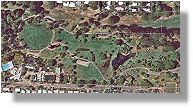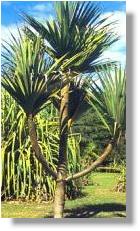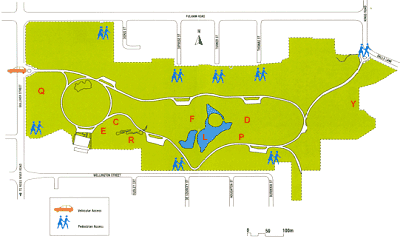| INTRODUCTION
Anderson Park is an arboretum containing fine specimens of tropical
tree ferns, palms and pandanus. Of note is an area devoted to
tropical fruit and economic plants. A representative collection
of Cape York Peninsula rainforest plants and examples of North
East Queensland plants are also to be found.
Anderson Park is a sleeping beauty amongst Townsville's numerous
natural attractions.
With substantial botanic credentials, including the Cape York
Peninsula Collection one of the world's largest collections of
pandanus, everyday visitors as well as botanical enthusiasts can
enjoy Anderson Park's diverse range of tropical attractions.
The giant expanses of the 20 hectare park belie the care and
consideration which is taken in the development of individual
species for the public's enjoyment.
The park was first developed in the early 1930's and, today,
is an innovative botanic accomplishment and wonderful public asset.
 Anderson Park Aerial
View
Anderson Park Aerial
View
Click to enlarge |
top
THE HISTORY
The original land for Anderson Park was acquired from the Water
and Electricity Supply Department in 1929. Much of the land is
now Mundingburra State School, (including the original Thuringowa
well), road reserve, and the Jubilee Bowls Club. Most of the existing
Park was acquired between 1956 and 1963 as land acquisitions.
The Park was named in appreciation of the work of William Anderson
(1845 - 1935), City of Townsville's first Curator of Parks (1878
- 1934). The present design was prepared in 1962 by Alan Wilson,
a Landscape Architect and Superintendent of Parks.
 The
Plant collection was originally laid out in Taxonomic groupings. The
Plant collection was originally laid out in Taxonomic groupings.
The Queensland Rainforest Section was developed as a joint
project between the 'Society for Growing Australian Plants, Townsville
Branch' and the Parks Department (1989 - 1991).
The land on which Anderson Park now resides once contained market
gardens, sugar cane fields and a well supplying Townsville’s
earliest water reticulation scheme.
Land for Anderson Park was officially acquired from the Water
and Electricity Supply Department in 1929.
In 1932, the Park was officially re-named after William Anderson,
the Council’s first Curator of Parks (from 1878 –
1934). And in the same year the earliest recorded plantings occurred;
these Raintree, Eucalyptus and Melaleuca trees now dominate the
landscape.
Anderson Park’s design, originally laid out in taxonomic
groupings, was prepared in 1962 by Alan Wilson, Superintendent
of Parks (from 1959 – 1969).
Today Anderson Park is an arboretum (focuses on growing trees)
containing fine specimens of tropical tree, palms and pandanus.
Of note is an area devoted to tropical fruit and economic plants.
top
THE PLANT COLLLECTION
- Pandanus - Renowned to be the largest cultivated collection
of Pandanus in any Botanic Garden. It includes most of the Australian
species as well as others from New Guinea, South-East Asia,
the western Pacific Islands and Madagascar. The exotic species
of the Pandanus are grouped together near the Palm Lawn, while
the Australian species are near the Cape York Section.
- Cape York Section - This area features palms, gingers,
Australian pandanus and ornamental trees from Far North Queensland
including Cape York Peninsula.
- Palms - A wide range of palms are displayed in an open
setting. Especially impressive are those from drier climates
such as Bismarckia nobilis; Orbignya cohune, Hyphaene and Latania
species.
- Conservatory - Is open only by appointment. It houses
a collection of tropical plants including bromeliads, gingers,
aroids, nepenthes (Pitcher plants), palms and cycads.
- Tropical Fruit Orchard - A good representation of fruit
trees and plants with edible parts suited to the tropics. Includes
commonly grown species such as Lychee, Black Sapote, Papaw,
Citrus and less common fruit such as Bread Fruit, Wampi, Miracle
Fruit, Dates, Cashews, Jack Fruit, and Longan. Plants
with edible parts include palm hearts, Cinnamon, Cloves, Coffee,
Tumeric and Ginger.
top

| Areas of Note |
Code |
Area |
E |
Orchard |
Q |
Queensland Rainforest Section |
Y |
Cape York Section |
P |
Palm Lawn |
F |
Ficus Lawn |
L |
Lotus Ponds |
C |
Tropical Conifers |
D |
Pandanus Collection |
R |
Rockery |
top
COUNCIL EVENTS
Barefoot in the Park
FACILITIES
| Rubbish Bins |
4 |
| Seating |
10 |
| Picnic Tables |
4 |
| Drinking Fountain |
4 |
How to Get There
Anderson Park is accessible by vehicle travelling south along
Gulliver Street and by foot off Fulham Road, Balls Lane, Gulliver
and Wellington Street. There are car parking spaces provided within
the grounds around the circuit roadway. Vehicles are not permitted
to park on the lawn. Public Conveniences are only open on the
weekends; unless prior arrangements are made.
Open Hours
Seven days a week, all year, sunrise to sunset.
For more information about Anderson
Park, contact Parks Services, Townsville City Council.
PARK BOOKINGS FOR PRIVATE EVENTS, CEREMONIES AND/OR ALCOHOL
CONSUMPTION MUST BE MADE THROUGH THE TOWNSVILLE CITY COUNCIL’S
PARKS SERVICES DEPARTMENT ON 4727 8330. |
